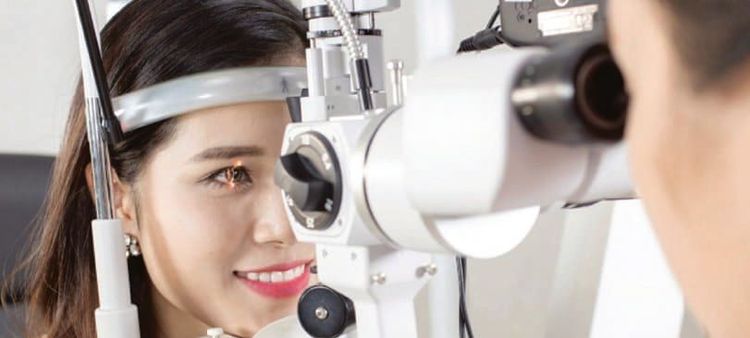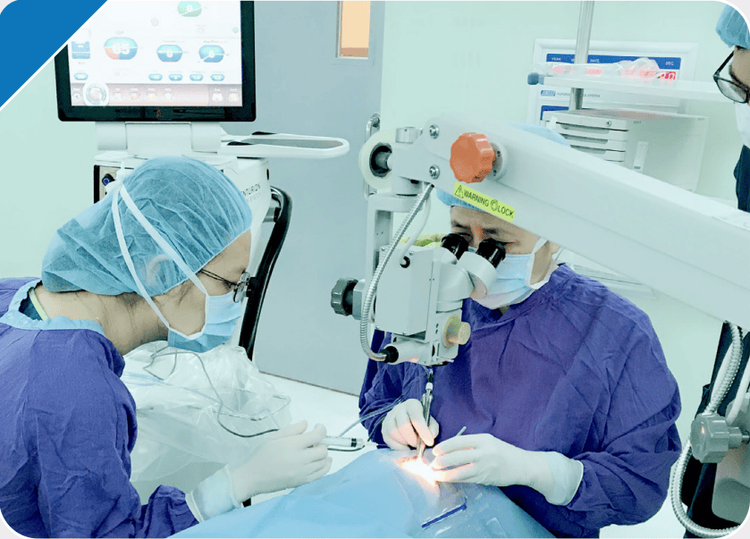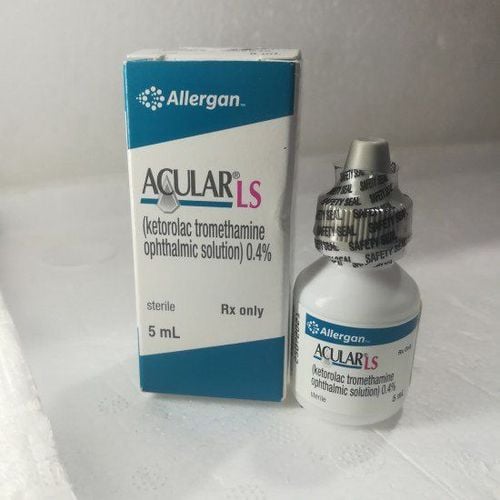This is an automatically translated article.
The article was professionally consulted with Specialist Doctor II Nguyen Thai Hung - Department of Medical Examination & Internal Medicine - Vinmec Danang International General Hospital.If you are over 60 years old and your vision is blurred or you see cloudy spots, you may have a cataract. This is a common condition in the elderly and can be treated by an ophthalmologist. Treatment of cataracts is not too difficult and currently cataract surgery is a modern and effective method, which is increasingly being applied.
1. Cataracts Overview
The lens is a soft, transparent structure that is responsible for bringing light into the retina so that the eye can see normally. Cataracts form when protein builds up inside the lens of the eye and causes it to become cloudy. This stops light from passing clearly and can cause you to lose some of your vision. There are many types of cataracts, depending on the cause. Cataracts can be congenital, acquired, or traumatic.Cataracts often appear and form slowly. You may not know they exist until proteins in the vitreous begin to block light and your vision is impaired. People with cataracts may then notice:
Blurry vision such as fog or a lot of dust Myopia (in older people) Changes in the way you perceive colors Problems with driving at night (eg, glare from headlights) Glare in the daytime Double vision in the affected eye Glasses or contact lenses that don't work well Some babies are born with cataracts crystals if the lens does not form as it should during pregnancy. These congenital cataracts can be caused by problems related to chromosomal abnormalities such as Down syndrome. They can also be hereditary, meaning the baby's parents can get the disease. It is important to have your child's vision checked regularly. The earlier a cataract is detected, the better a child's vision will be in the long run. The first vision test takes place when your baby is an infant. Your doctor will check your eyes for cataracts and other problems. Your child will continue to have vision tests throughout childhood. Early recognition of abnormal vision problems by parents can be challenging. Children may not even know that something is wrong with their vision. In some situations, they may say they are seeing two of things ("double vision") or that the lights are too bright.
2. How are cataracts diagnosed?
To find out if you have cataracts, your doctor will want to know all of your symptoms, so talk to your doctor in detail. They will look closely into your eyes and may perform a number of tests including:Vision test. This is a fancy way of saying "check your eyesight". Your doctor will ask you to read letters from a distance to see how good your eyesight is. Both eyes will be examined in turn. They may also then do a luminance test, where they shine a bright light into your eyes and then ask you to read the letters. Slit lamp examination: The doctor uses a special microscope with a strong light source that allows different parts of the eye to be examined. They will look at your cornea, the clear outer layer. They will also examine the iris - the colored part of your eye - and the lens that is behind it. Lenses bend light as it enters your eyes so you can see things clearly. Retinal examination. Your doctor will put drops in your eyes to dilate your pupils, the dark spots in the middle that control how much light gets in. This allows them to clearly see the retinal tissue around your eye and see more clearly the cataract.

3. Cataract Treatment Methods
Surgery is the only way to treat cataracts, but you may not need it right away. If cataracts are detected at an early stage, you can use new lenses. A stronger lens may help correct vision for a while.If you have trouble reading, try using a brighter light or a magnifying glass. If you have problems with glare, check out special glasses with anti-glare coatings. They can come into play when you're driving at night.
Monitor closely how cataracts affect the way you see. When your vision problems start to interfere with your daily routine, especially if they make driving dangerous, it's time to talk to your doctor about surgery.
There are several types of surgery for cataracts, but they all have one thing in common: The surgeon removes the cloudy lens and replaces it with an artificial lens. It may feel a little uncomfortable to think about surgery on a sensitive area like your eye, but it's a very common treatment. You will be given a local anesthetic to numb your eyes and will be awake during the surgery, and you will be sedated and will not feel any pain or anxiety. The surgery usually takes about 15 to 20 minutes and you don't need to stay in the hospital overnight. In the case of cataracts in both eyes, the doctor operates on one eye and waits until your first eye heals before proceeding to the second eye. More than 95% of people who have undergone surgery say they can see better after surgery.
4. What is cataract surgery?
Cataracts are a modern cataract surgery procedure in which the lens of the eye is emulsified using ultrasound waves and is aspirated from the eye for removal. The aspirated fluid is replaced by a balanced saline irrigation to maintain the transparent anterior chamber.Choosing the right anesthesia method is essential for eye surgery. Local anesthesia is most commonly used, usually by instilling a local anesthetic such as tetracaine or lidocaine. Alternatively, lidocaine or the longer-acting anesthetic bupivacaine can be injected into the surrounding area (peribulbar mass) or behind (retrobulbar mass) the eye muscle cone to more fully immobilize the extraocular muscles and minimize sensation. pain sensation. Sometimes a facial nerve block can be performed using lidocaine and bupivacaine to reduce eyelid spasm. General anesthesia is recommended for children, cataracts due to eye trauma, and for patients who are too fearful or uncooperative.
The patient will be sterile to prepare the surgical area, including using an antiseptic such as povidone-iodine. Use sterile drapes, gowns and gloves. A plastic plate with a reservoir that collects the fluid during the vitreous fusion process. A specialized instrument is inserted to keep the eyelids open.

The transducer is an ultrasonic handpiece with a titanium or steel needle. The needle tip vibrates at ultrasonic frequency to emulsify the cataract while the pump draws fluid through the needle tip. The cloudy lens is usually broken into two or four pieces, and each piece is emulsified and sucked out by suction. The emulsification process of the vitreous makes subsequent aspiration easier. After total removal of the hard central lens core by means of a fusion method, the softer outer lens cover is removed by suction alone.
As with other types of cataract surgery, an implantable lens (IOL) is placed into the remaining vitreous capsule. To implant poly IOL (methyl methacrylate) (PMMA), the incision must be enlarged. To implant a foldable IOL, the incision does not need to be enlarged. Foldable IOLs, made of silicon or acrylic with an appropriate power supply, are folded using a proprietary holder/pair or insertion device. Then, the artificial lens is inserted and placed into the posterior cavity in the capsule of the nucleus (implantation in the bag). Because only a small incision is required, little or even no stitches are needed, and the patient's recovery time is often short, many doctors prefer a foldable IOL.
5. Follow-up of patients after cataract surgery
For most people, recovery goes smoothly. How long it takes to recover depends on the type of surgery and individual response. But in general, people will notice that their vision gets much better after a day or so. After about a week or two, you can go back to doing all the things you enjoy.As with any surgery, there are some risks involved. Very rare, but you can get an infection or bleed. There is also the possibility of the retina being pulled away from the tissues at the back of the eye. This is called a detached retina.
Some people have a problem after cataract surgery called posterior cataract (PCO). Your vision may become cloudy again because the capsule that holds the artificial lens in your eye thickens. Laser surgery called YAG can correct this problem. Sometimes, this can happen 1 year after cataract surgery.

Please dial HOTLINE for more information or register for an appointment HERE. Download MyVinmec app to make appointments faster and to manage your bookings easily.














